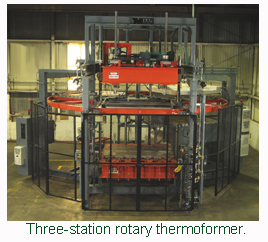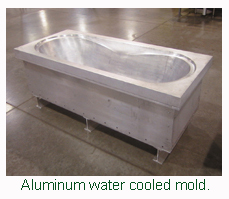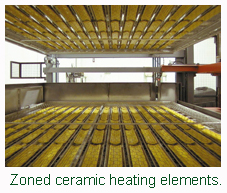|
THERMOFORMING: Top Ten Tips to Becoming More Efficient in Thermoforming
As today’s heavy gauge thermoforming market is
growing and becoming more competitive, companies
are looking for better ways to gain efficiencies.
A large portion of a company’s success comes from the
efficiencies they have or the efficiencies they create.
Through years of working with thermoformers, we often
work with companies that we can help gain major efficiencies.
Although engineering firms, suppliers and consultants
are not necessarily needed to implement
improvements, they all have the continual opportunity to
work with thousands of thermoformers and thousands of
different applications. From a general viewpoint, here are
10 tips to be more efficient, or areas where improvements
can be implemented. With the proper knowledge, companies
should assess their strengths and weaknesses and
begin preparing for future plans to address their major
inefficiencies.
1. Outdated
Equipment
As thermoforming
is not a new
process, thermoforming
equipment
 has been around for
over 50 years. This
does not mean you
should keep your
machines for 50 years! Begin putting together long-term
plans to replace or upgrade them. Old, inefficient
machines are the single largest item that restricts manufacturers’
ability to run at their most efficient. Older
machines also tend to have limited capabilities and offer
no real competitive advantage. The term, “it paid for it self
already” does not make you efficient.
has been around for
over 50 years. This
does not mean you
should keep your
machines for 50 years! Begin putting together long-term
plans to replace or upgrade them. Old, inefficient
machines are the single largest item that restricts manufacturers’
ability to run at their most efficient. Older
machines also tend to have limited capabilities and offer
no real competitive advantage. The term, “it paid for it self
already” does not make you efficient.
A large portion of a company’s success comes from the
equipment they utilize. If you never investigate the latest
technology or do not have plans to invest in the latest technology,
this may be the single largest mistake you can
make. With all of the technological advancements available
in today’s new machinery, older machines cannot be compared
and certainly cannot compete in terms of performance,
cycle time, material distribution, energy use, repeatability,
change-over time, flexibility and even maintenance.
2. Tooling/Molds
One of the most limiting factors leading to running efficient
stems from poor mold designs and, even worse,
the type of material chosen to construct the mold.
 Regardless of your machinery being new or old, a
bad mold will dictate your ability to be efficient.
Regardless of your machinery being new or old, a
bad mold will dictate your ability to be efficient.
Although the volume of products produced or the
design of the finished product may dictate what can
be used, too many formers start with looking for the
least expensive way to get a mold and start producing
products the fastest. A badly designed mold or
molds that are not water cooled aluminum will allow
competitors to redesign and improve cycle times
lowering overall manufacturing costs. Patching up
poorly designed molds may help, but will only allow
you to run your product at what the mold design
allows for. Too often formers are running high volume
jobs, in some cases several shifts, with multiple
non-water cooled molds; when one good aluminum
water cooled mold can be utilized to produce parts
up to three times faster. Production cycle times
should never be based upon how long it takes your
mold to cool off between shots unless the volume is
very low or you are prototyping. 3.
Cycle Times
As there are many ways to improve cycle times,
we far too often see products running too slow.
Thermoformers need to take the time to improve, determine
the bottle neck and implement a way to correct it. If
the problem is heating times, make plans to improve your
ovens or spend more time setting them up and tweaking
them. If the issue is forming and cooling times, look to
replace tooling with better molds or investigate alternative
cooling options. If secondary operations are much
more time consuming, look for more options and capabilities
to speed up the process or be open to jobbing the
work out to someone who may be more efficient in that
portion of the process.
4. Sheet Size
Use smaller sheets: far too many thermoformers are
using too much material. Look for ways to reduce your
material costs and implement a new standard. Look at
your clamp frames; are you clamping more than 1/2”? Do
not try to get 50 years out of a piece of clamp frame, you
will easily spend the money in material costs in the long
run due to sheets pulling out, oversizing the sheet and
increased scrap rates. Replace damaged or bent frames:
utilize frames that require less than 1 inch in the clamp.
Work on utilizing thinner gauge sheets too. This can be
achieved with more oven control, better oven designs and
the use of different forming techniques. Material gauges
can be greatly reduced and still meet your finished parts’
minimum thickness requirements.
5. Ovens and Oven Controls
Older ovens need attention. Maintain them to get the
most out of your machines. Costly retrofits are one option,
but typically only help in one area of your machine. For
30% to 40% of a new machine cost, oven retrofits are typically
seen as a short term solution to gain efficiencies.
Get more oven control, or at least some control. Machines
with no “Zones” should not be used unless you have no competition
and are a non-profit organization. The additional
utility costs for operating the entire oven when smaller
sheets are used is not efficient and costs too much with
today’s utility prices. You need oven zones to shut off areas
that are not heating the sheet, zones also allow you to gain
more control over the process to decrease heating times and
even decrease starting sheet gauges. Having zones in your
oven also eliminates the need to physically screen an oven or
block heat transferring into the sheet. Physical screening is
both time consuming and an inefficient use of energy. 6.
Over Heating the Sheet
Stop overheating the sheet. Many thermoformers are
overheating the sheet as they do not know what temperature
 the sheet is. The days of visually detecting sag or
touching the sheet to measure temperature are gone.
Photo eyes and infrared pyrometers are used for detecting
sheet sag or sheet temperature. Some of these devices
can be purchased for less than $100. If you overheat the
sheet, forming and cooling times are extended, making
cycle times much longer than necessary. Not to mention
the additional wear and tear on your machine, your mold,
the extra costs you pay for labor and the added utility cost
used to overheat the material.
the sheet is. The days of visually detecting sag or
touching the sheet to measure temperature are gone.
Photo eyes and infrared pyrometers are used for detecting
sheet sag or sheet temperature. Some of these devices
can be purchased for less than $100. If you overheat the
sheet, forming and cooling times are extended, making
cycle times much longer than necessary. Not to mention
the additional wear and tear on your machine, your mold,
the extra costs you pay for labor and the added utility cost
used to overheat the material.
7. PLC’s and Quick Set Ups
Updating machines from manual timers to PLC controls
is a step forward but PLC’s programmed by nonindustry
professionals will most likely limit the machines capabilities
and only allow a slight increase in efficiencies. Again,
this should be looked at as a short term fix.
Thermoforming machine manufacturers who build these
controllers can at least guarantee flexibility, full functioning
and support.
Companies must fully investigate the control systems
and all features that will benefit their operation. The latest
controllers allow you to memorize all functions of the
machine for each job you run. This means all the time it
takes to manually program a machine is reduced to the
touch of a button the second time the machine is set up.
The possibility of damaging the machine or producing
scrap is greatly reduced, and the ease of continually
tweaking specific applications is simplified.
8. Cooling
The thermoforming process may begin with heating the
sheet, but acquiring the fastest cycle times is not solely
based on how fast you can heat the sheet. In order to
establish faster cycles with materials that have longer
cooling characteristics (than heating characteristics), you
must accommodate the cooling process.
Whether you need additional cooling fans, a directional
blower, spray mist or even air conditioned
cooling, there are numerous
ways to incorporate these. Precise
location and positioning of these cooling
systems will also lead to faster
cooling times. Automated in-machine
post cooling may be needed for heavy
gauge products in order to run the
machine based on heating times
rather than cooling times. Depending
on part specifications and tolerances,
post cooling can be the key to gaining
more parts per hour.
9. Trimming
Too often thermoforming machine
cycle times are extended to match the
trimming process time. Again, companies
who investigate in the newest
methods of trimming and trimming
speeds may find ways to speed up the
parts trimmed per hour. With newer
equipment with faster speeds, some
applications can see a 300% increase
in parts per hour. A little more time
spent on tightening up the programming
can now result in parts per hour
increases as high as 500%.
10. Vacuum
Insufficient volume, recovery time
and insufficient pressure are often the
cause for deficient processing causing part variation and
increasing scrap rates. Determine the amount of work to
be done in cubic feet or cubic inches. Items needed to calculate
amount of work are: process (possible predraw box),
sag, tool and tool cavity. Large tool cavities are back-filled
with polyethylene balls to reduce the amount of cubic feet
needed. Determining the flow in cubic feet per minute will
result in the amount of time at a specific pressure (hg) to
evacuate the needed cubic feet of work. Items needed to
calculate are: tool port size, distance from tool port to vacuum
valve, vacuum valve flow in cfm, starting pressure and
tank volume. By adding pump starting pressure and cfm
capacity, the recovery time may be calculated.
Although this is all easier said than done, companies
who are in it for the long run will continually look for ways
to improve and gain efficiencies. Whether you develop
short or long term plans, or implement temporary fixes to
help gain efficiencies, you must start preparing to stay
ahead of the market.
Written by Michael P. Alongi, Sales Director for MAAC
Machinery Corp., manufacturers of a wide range of cutsheet
thermoforming machinery.
For more information, contact MAAC Machinery
Corp., 590 Tower Blvd., Carol Stream, IL 60188, 630-665-1700, Fax: 630-665-7799, E-mail: sales@maacmachinery.com, Web: www.maacmachinery.com
|